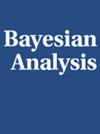Bayesian Sparse Spiked Covariance Model with a Continuous Matrix Shrinkage Prior
IF 2.5
2区 数学
Q1 MATHEMATICS, INTERDISCIPLINARY APPLICATIONS
引用次数: 3
Abstract
. We propose a Bayesian methodology for estimating spiked covariance matrices with a jointly sparse structure in high dimensions. The spiked covariance matrix is reparameterized in terms of the latent factor model, where the loading matrix is equipped with a novel matrix spike-and-slab LASSO prior, which is a continuous shrinkage prior for modeling jointly sparse matrices. We establish the rate-optimal posterior contraction for the covariance matrix with respect to the spectral norm as well as that for the principal subspace with respect to the projection spectral norm loss. We also study the posterior contraction rate of the principal subspace with respect to the two-to-infinity norm loss, a novel loss function measuring the distance between subspaces that is able to capture entrywise eigenvector perturbations. We show that the posterior contraction rate with respect to the two-to-infinity norm loss is tighter than that with respect to the routinely used projection spectral norm loss under certain low-rank and bounded coherence conditions. In addition, a point estimator for the principal subspace is proposed with the rate-optimal risk bound with respect to the projection spectral norm loss. The numerical performance of the proposed methodology is assessed through synthetic examples and the analysis of a real-world face data example. 62H25, 62C10; secondary 62H12.具有连续矩阵收缩先验的贝叶斯稀疏尖刺协方差模型
。提出了一种估计高维联合稀疏结构的尖峰协方差矩阵的贝叶斯方法。利用潜因子模型对尖刺协方差矩阵进行重新参数化,在加载矩阵中建立了一种新的矩阵尖刺-板LASSO先验,这是一种用于联合稀疏矩阵建模的连续收缩先验。我们建立了协方差矩阵相对于谱范数以及主子空间相对于投影谱范数损失的率最优后验收缩。我们还研究了主子空间相对于2到无穷范数损失的后验收缩率,这是一种新的损失函数,测量子空间之间的距离,能够捕获入口方向的特征向量扰动。我们表明,在某些低秩和有界相干条件下,相对于2到无穷范数损失的后验收缩率比相对于常规使用的投影谱范数损失的后验收缩率更紧。此外,针对投影谱范数损失,提出了一个具有速率最优风险界的主子空间点估计。通过综合算例和对真实人脸数据的分析,对所提方法的数值性能进行了评价。62 h25, 62年10大;二次62 h12。
本文章由计算机程序翻译,如有差异,请以英文原文为准。
求助全文
约1分钟内获得全文
求助全文
来源期刊

Bayesian Analysis
数学-数学跨学科应用
CiteScore
6.50
自引率
13.60%
发文量
59
审稿时长
>12 weeks
期刊介绍:
Bayesian Analysis is an electronic journal of the International Society for Bayesian Analysis. It seeks to publish a wide range of articles that demonstrate or discuss Bayesian methods in some theoretical or applied context. The journal welcomes submissions involving presentation of new computational and statistical methods; critical reviews and discussions of existing approaches; historical perspectives; description of important scientific or policy application areas; case studies; and methods for experimental design, data collection, data sharing, or data mining.
Evaluation of submissions is based on importance of content and effectiveness of communication. Discussion papers are typically chosen by the Editor in Chief, or suggested by an Editor, among the regular submissions. In addition, the Journal encourages individual authors to submit manuscripts for consideration as discussion papers.
 求助内容:
求助内容: 应助结果提醒方式:
应助结果提醒方式:


